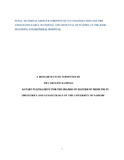| dc.contributor.author | Kaminja, Caroline | |
| dc.date.accessioned | 2016-04-20T08:10:21Z | |
| dc.date.available | 2016-04-20T08:10:21Z | |
| dc.date.issued | 2015 | |
| dc.identifier.uri | http://hdl.handle.net/11295/94343 | |
| dc.description.abstract | BACKGROUND
Group B streptococcus is a gram positive streptococcus that is a major cause of bacterial infections in the perinatal period including amnionitis,urinary tract infections,endometritis in the pregnant women carriers of the organism in the rectovaginal compartment. At birth,50-65% of infants born to colonised mothers have positive cultures taken from mucus membranes and the skin. 98% of the colonised newborns remain healthy but 1-2% develop invasive disease.
Published information about the prevalence of colonization by GBS among pregnant women in Kenya is scarce. Therefore the aim of the study was to determine the magnitude of GBS among ante natal women and the subsequent maternal and neonatal outcomes post-delivery. This is meant to stimulate research interest in this area which may indirectly impact the high maternal and infant mortality rate in the country.
OBJECTIVE
To determine the incidence of group B streptococcus among pregnant women 35-37 weeks gestation and the maternal and neonatal outcomes within 48 hours postnatal.
STUDY SETTING
This study was conducted in the antenatal clinic,antenatal and postnatal wards of the Kisii Teaching and Referral hospital.
SUBJECTS
Pregnant women 35-37 weeks gestation who meet the inclusion criteria
Neonates born to the study participants.
METHODS
This was a descriptive cohort study where consecutive sampling was used. Pregnant women 35-37 weeks gestation were sampled by taking rectovaginal swabs and culturing for growth of Group B Streptococcus. The rectovaginal swabs collected were transported to Aga Khan
xii
University hospital, Kisumu where the process of culturing was commenced within 24 hours. The women were then followed up to determine the maternal and neonatal outcomes up to 48 hours post natal. The data was analysed using the SPSS software version 18.0 and evaluated statistically by Fischer exact test. Statistical significance was determined as P value < 0.05.
RESULTS
A total of 914 women were approached in the antenatal clinics during the study period, 714 women were eligible and 200 of them were recruited into the study after meeting the inclusion criteria. 182 women were followed up until the immediate postpartum period. In total, 6 out of the 200 pregnant women 35-37 weeks gestation attending ANC clinic at Kisii teaching and referral hospital had vaginal colonisation with group B streptococcus yielding a prevalence of 3% in this cohort. Majority of the colonised women (83.3%) had only primary level education and 16.7% had college education as compared to 28.4% of uncolonised women who had primary education and 22.7% who had college education. There was a statistically significant association between level of education and GBS colonisation(P=0.035). The findings of this study showed that there was a significant association between puerperal sepsis and GBS colonisation(P=0.046) as well as a significant association between birth weight and GBS colonisation (P=0.018). 50% of GBS positive mothers delivered neonates who weighed less than 2500g. No significant association was found between neonatal sepsis and GBS colonisation(P=0.259). In this study the GBS was sensitive to chloramphenicol, ampicillin, doxycycline, azithromycin, netilmycin and ciprofloxacin.
CONCLUSION
There was a low prevalence of maternal group B streptococcus infection among the pregnant women in the study. GBS colonisation was associated with adverse maternal outcomes like puerperal sepsis. Low level of education was significantly associated with GBS colonisation.
RECOMMENDATION
From the results, it would be recommended that Group B Streptococcus should be highly considered as one of the causative organisms in cases of puerperal sepsis where laboratory services are not readily available and treatment given accordingly .
xiii
In the event that neonates born with a birthweight of less than 2500g develop invasive disease, the clinician should have a high index of suspicion for GBS disease and treat accordingly especially in the resource poor settings | en_US |
| dc.language.iso | en | en_US |
| dc.publisher | University of Nairobi | en_US |
| dc.subject | Maternal group b streptococcus colonization | en_US |
| dc.title | Maternal group b streptococcus colonization and the associated early maternal and neonatal outcomes at the Kisii Teaching and Referral Hospital | en_US |
| dc.type | Thesis | en_US |
| dc.description.department | a
Department of Psychiatry, University of Nairobi, ; bDepartment of Mental Health, School of Medicine,
Moi University, Eldoret, Kenya | |

